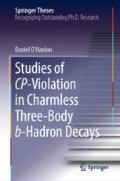Abstract
The predictions of the Standard Model of fundamental interactions yield remarkable agreement with experimental measurements, with some consistent to one part in \(10^9\) (Hanneke, Hoogerheide and Gabrielse, Phys. Rev. A83, 052122 (2011) [1]), and as such the Standard Model currently represents humanity’s best understanding of the behaviour of all known elementary particles. Nevertheless, there is mounting evidence for physical observations inconsistent with the predictions of the Standard Model: astrophysical observations of dark matter, dark energy, and the baryon asymmetry of the universe can only result from hitherto unknown fundamental interactions, and internal inconsistencies regarding the nature of neutrino masses challenge the completeness of the Standard Model.
Access this chapter
Tax calculation will be finalised at checkout
Purchases are for personal use only
Notes
- 1.
Natural units are used throughout this thesis, where \(\hbar = c = 1\), and inclusion of charge-conjugate processes is implied, unless otherwise specified.
References
D. Hanneke, S.F. Hoogerheide, G. Gabrielse, Cavity control of a single-electron quantum cyclotron: measuring the electron magnetic moment. Phys. Rev. A 83, 052122 (2011). https://doi.org/10.1103/PhysRevA.83.052122. arXiv:1009.4831
J.D. Cockroft, E.T.S. Walton, Artificial production of fast protons. Nature 129 (1932)
H.-Y. Cheng, C.-K. Chua, Branching fractions and direct CP violation in charmless three-body decays of B mesons. Phys. Rev. D 88, 114014 (2013). https://doi.org/10.1103/PhysRevD.88.114014. arXiv:1308.5139
S. Kränkl, T. Mannel, J. Virto, Three-body non-leptonic B decays and QCD factorization. Nucl. Phys. B899, 247 (2015). https://doi.org/10.1016/j.nuclphysb.2015.08.004, arXiv:1505.04111
S. Cheng, A. Khodjamirian, J. Virto, \(B\rightarrow \pi \pi \) form factors from light-cone sum rules with \(B\)-meson distribution amplitudes. arXiv:1701.01633
J. Lewis, R. van Kooten, Review of physics results from the Tevatron: heavy flavor physics. Int. J. Mod. Phys. A 30, 1541003 (2015). https://doi.org/10.1142/S0217751X15410031. arXiv:1412.5211
C. Patrignani et al., Review of particle physics. Chin. Phys. C40, 100001 (2016). https://doi.org/10.1088/1674-1137/40/10/100001. 2017 update
Author information
Authors and Affiliations
Corresponding author
Rights and permissions
Copyright information
© 2018 Springer Nature Switzerland AG
About this chapter
Cite this chapter
O’Hanlon, D. (2018). Outline. In: Studies of CP-Violation in Charmless Three-Body b-Hadron Decays. Springer Theses. Springer, Cham. https://doi.org/10.1007/978-3-030-02206-8_1
Download citation
DOI: https://doi.org/10.1007/978-3-030-02206-8_1
Published:
Publisher Name: Springer, Cham
Print ISBN: 978-3-030-02205-1
Online ISBN: 978-3-030-02206-8
eBook Packages: Physics and AstronomyPhysics and Astronomy (R0)

